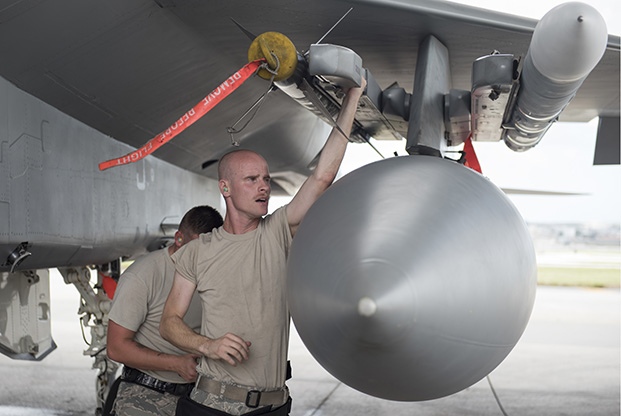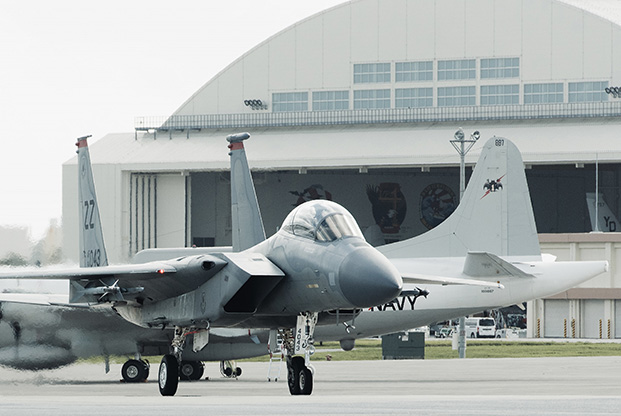
SrA. Christopher Leslie, 44th Aircraft Maintenance Unit, loads an AIM-9 heat-seeking missile during Kadena AB, Japan’s annual weapons load competition. Photo: A1C Greg Erwin
Kadena AFB, Japan—
Looking out of the 360-degree windows in the air traffic control tower here, there’s a clear view of the Kadena Marina and the East China Sea to the west, a densely populated Kadena town just to the north, and the city of Naha to the southwest—close enough that Naha Airport’s airspace overlaps with Kadena’s. To the east, beyond the trees and towns, is the Philippine Sea.
Two F-15Cs are approaching quickly from the south side of the tower as a C-130 lifts off toward the east. A helicopter is slowly towed from its hangar.
Kadena, in the heart of Okinawa, Japan, is the largest US air base in the Pacific, and the sixth busiest in the Air Force worldwide. With a typhoon bearing down on the base, things could get busier still as leaders ponder whether to evacuate as many as 100 aircraft to avoid the storm.
“When they say we’re the keystone of the Pacific, that’s no lie,” said Maj. Tim Bills, the airfield operations flight commander.
Kadena is home to the 18th Wing—the largest combat wing in the Air Force—and to detachments from three other services. The base is also a hub for Air Mobility Command cargo operations, and a key force projection platform for Indo-Pacific Command.
“The 18th Wing is a mission wing,” Commander Brig. Gen. Case A. Cunningham said. “There’s any number of missions that we’re responsible for, [in regards to] Pacific Air Forces and Indo-PACOM. Air superiority, airborne warning and control, combat search and rescue, and then aerial refueling are the significant ones.”
Two F-15 Eagle squadrons, a KC-135 Stratotanker refueling squadron, an E-3 AWACS airborne air control squadron, two rescue squadrons and an aeromedical evacuation squadron are among the 26 Air Force squadrons here.
Also here: Navy P-8 reconnaissance and patrol aircraft; P-3 anti-submarine patrol aircraft, and fighter jets when aircraft carriers are nearby. The base also serves as a divert location for the civilian airport and the Japan Air Self-Defense Force.
“We have an enormous selection of aircraft,” said TSgt. Chris Anderson, an air traffic control watch supervisor.
While local control talks to aircraft overhead, ground control is watching all the vehicles on the ground. Anderson can make on-the-spot air traffic decisions, making him “kind of the last step” before an incident can happen.
“So if I’m listening to everybody, like if my ground (control) and local (control) are doing something and one does something that he shouldn’t, I can stop it, so we don’t have a plane hitting a car or a plane hitting a truck, or even two planes hitting together,” Anderson explained.
This is Anderson’s second tour in Okinawa, but he already had several years of experience before he arrived on the island the first time. A busy tower demands experienced air traffic controllers.
“We have everything from the Navy, [and] the Army flying through, we have all the sister services come here, we have the Japanese that come here, we have the Aussies that come here—anybody— NATO pretty much comes through here,” he said. “That’s a big difference, talking to different cultures, different nations.”
SrA. Jessica Newman, an aircraft management shift lead, said she loves how busy the airfield is. “Kadena’s a beast,” Newman said. “Our airfield is just so big.”

Kadena Air Base is a busy transit point for all the services. An 18th Wing F-15C Eagle (foreground) passes by a US Navy P-3 Orion. The Navy rotates P-3 squadrons to Kadena routinely. Photo: SrA. Omari Bernard
Roughly 600 miles south of Korea, 500 miles east of China, and 950 miles southwest of Tokyo, Okinawa is a critical central hub for Indo-PACOM and home not just to the 18th Wing, but also to III Marine Expeditionary Force and Marine Forces Japan, and four Army Patriot Missile batteries—a hedge against ballistic missile attack.
Just 70 miles long and averaging seven miles wide, the island is packed with a dozen interconnected US military bases.
“Okinawa is a joint island,” Cunningham said. “ So, all services are represented here in significant fashion, and we work together as a joint team.”
The location makes it an ideal launching pad for operations all over the region.
“You take the Thailand cave rescue,” Cunningham said. “A lot of those airmen came from Kadena. We have very special capabilities that enabled that, but it’s also our location that enabled us to respond quickly.”
Likewise, with responses to the 2011 earthquake and tsunami in Japan, the 2015 earthquake in Nepal, and a 2013 typhoon in the Philippines.
“All of those are opportunities for us to provide that humanitarian assistance and disaster relief from Kadena,” Cunningham said, whether that means direct support from the 18th Wing or a base to support US-based operations.
The senior US military officer on Okinawa is Marine Corps Lt. Gen. Eric M. Smith, commander of III Marine Expeditionary Force and Marine Forces Japan. He is responsible for the sensitive political-military affairs here, which have long been a sore spot with a portion of the island’s population.
Because of the tensions and the level of activity on the airfield, officials take pains to suppress noise and minimize the impact on the local community.
Quiet hours are strictly enforced, and only rarely are operators permitted to take off or land between 10 p.m. and 6 a.m.
Instead of taxiing, aircraft are towed to minimize noise; service aprons 5 and 6—the two closest to Kadena town—are kept empty.
Even routine takeoffs and landings are planned to reduce noise, with early morning departures oriented toward the water rather than populated areas.
Tensions have been high since before the US and Japan signed a bilateral agreement in 1996 to reduce the US military presence on Okinawa. The reduction has been slow.
A plan to close Marine Corps Air Station Futenma and move it from a heavily populated area south of Kadena to a more sparsely populated area in the northern part of the island continues to face stiff opposition, including from Okinawa’s new governor, Denny Tamaki, who has been steadfast in his opposition to the US military presence.
Many bases on the island see regular protests, as Okinawans complain about aircraft noise, accidents, and violent crimes committed by US troops. Frequent radio commercials remind US troops that they are guests in a foreign country and that their actions have consequences.
Not so well-known, Cunningham says, is “how incredible the community here is on Okinawa.”
“I can’t overemphasize enough the importance and the strength of the alliance that we have here with the Japan Self-Defense Force and our responsibilities,” he said.
“They’re amazing friends, they’re amazing allies … and we work to continue what is already a strong relationship. We work to continue to strengthen that every single day,” said Cunningham.
Jennifer Hlad is a freelance journalist based in Okinawa, Japan, and a former Air Force Magazine senior editor.
